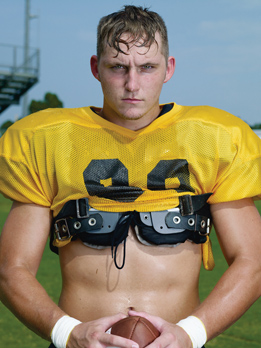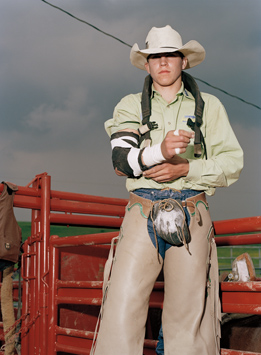 Summer 2011
Summer 2011|
|
Miked Signals
Sports-crazed Pittsburghers know all about the bond between athlete and fan. A new traveling exhibition at The Warhol tackles the subject as a way to rethink gender norms.
Of course, these traditions aren’t new. Glorifying athletes goes back to ancient Greece, where the faithful venerated statues of nude youths known as kouroi in their temples. This summer, The Andy Warhol Museum digs deeper into the complex relationship between athletes and fans with Mixed Signals: Artists Consider Masculinity in Sports, a traveling exhibition organized by Independent Curators International of New York. This exhibition of work by well-known contemporary artists, including two Pittsburghers added by The Warhol, draws imagery from the American sports scene to examine what we really admire—or overlook—beneath those team colors. When televised sporting events catapulted individual athletes to stardom in the 1970s, Andy Warhol, not surprisingly, was one of the first artists to take them on as subjects. In his Athletes Series of 1979, he captured the images of sports greats Muhammad Ali, O.J. Simpson, Pelé, Jack Nicklaus, and Chris Evert, among others. The Ali portrait, along with Polaroid photos and preliminary drawings of the work, are on view as part of Mixed Signals. The exhibition features sports as diverse as rodeo riding to NASCAR and media from sculpture to video. While the majority of works are photographs, they’re far from Sports Illustrated’s brand of telephoto artwork. “This show isn’t about athletes as celebrities,” says Eric Shiner, acting director of The Warhol. “It shows how sports penetrate society. We’re hoping that this show turns the camera on the ideal of masculine beauty and youth as a way to rethink gender norms.” Among the photographers included is Catherine Opie. An artist known for her portraits of tough, gender-defying women, in Mixed Signals she examines male high school football players caught in somber, self-conscious poses or in action on the field. Mark Bradford’s video, Practice, features the six-foot, seven-inches-tall artist himself, playing basketball in a Lakers uniform that trails the court as a full-skirted ballgown. (Bradford’s rooftop installation, HELP US, was a highlight of the 2008 Carnegie International.) “We’re hoping that this show turns the camera on the ideal of masculine beauty and youth as a way to rethink gender norms.”
-Eric Shiner, acting director of The Warhol
On the local front, Pittsburgh photo-grapher Duane Rieder’s Our Father captures the Steelers locker room scene before the 2005 AFC Championship game against the New England Patriots. The image of a kneeling team, linking hands as they pray, centers on Troy Polamalu and Jerome Bettis. The massive sepia-toned digital print stretches to heroic proportions, extending nearly six feet wide. Rieder says the vulnerability he captured contrasts with the imagery usually portrayed in the NFL. “When you watch them play, they’re macho,” says Rieder. “This is the softer side of these guys.” Work by other artists implies the burden of being pigeonholed as a professional athlete. Hank Willis Thomas bluntly suggests exploitation in the photo manipulation of Basketball and Chain, a work which shackles an NBA basketball to the right ankle of a soaring player’s legs. In Scarred Chest, Thomas repeats a brand in the shape of a Nike logo across a headless black, muscled torso, evoking images of both slavery and fraternity.
“When you see something that grips you, something as simple as the action figure, it’s beautiful in its own right,” explains the Robert Morris University professor, a London native now living in Sewickley. “It’s irresistible. It forces you to work with it—taking something from pop culture, subverting it, and giving it a serious message. [The work] should provoke questions that you want people to answer.” Shiner wants those answers to come from Pittsburgh sports fans, as well as art lovers. He sees Mixed Signals as another way for the museum to engage a new audience. “Look at our location,” he says, pointing in the direction of PNC Park and Heinz Field, each just a block or two down the street from the museum’s Sandusky Street location. “Sports are a perfect vehicle for us to welcome new visitors to the museum.” Exploring the intersection of art and sport isn’t something entirely new to the museum. Last year Warhol educators partnered with the Pittsburgh Penguins Foundation on a project that challenged local teachers and students to explore the art of play—including themes of sportsmanship, teamwork, and the role of the sports celebrity in contemporary culture—for an exhibition displayed during the Winter Classic. “Sports and art are two lifelong activities that lead to a healthy and creative society,” says Abby Franzen-Sheehan, associate curator of education interpretation and resources at The Warhol. “Part of the goal of the student exhibition was to drive home the point that play is involved both as an athlete and as an artist.” Among the public events scheduled in conjunction with Mixed Signals is the July 29 screening of Soccer As Never Before, a rarely-shown German documentary. During a match between Manchester United and Coventry, film director Hellmuth Costard focuses eight cameras solely on the moves of Man U’s legendary striker George Best, an international star and famously charming public partier who died in 2005 at the age of 59 after a long battle with illnesses linked to alcoholism. Best’s well-known quip about his life and career perhaps sheds some light on some of the trappings of being an iconic masculine celebrity: “I spent a lot of money on booze, birds [aka women], and fast cars—the rest I just squandered.”
|
Spacewalker · Pittsburgh Bred · Tracking the Origins of Humans · The Ragnar Kjartansson Experience · Special Section: A Tribute to Our Donors · Directors' Note · NewsWorthy · Face Time: John Wetenhall · About Town: Show-stopping Science · Science & Nature: Remembering Brad · The Big Picture
 |
Copyright © 2017 CARNEGIE Magazine. All rights reserved. |


